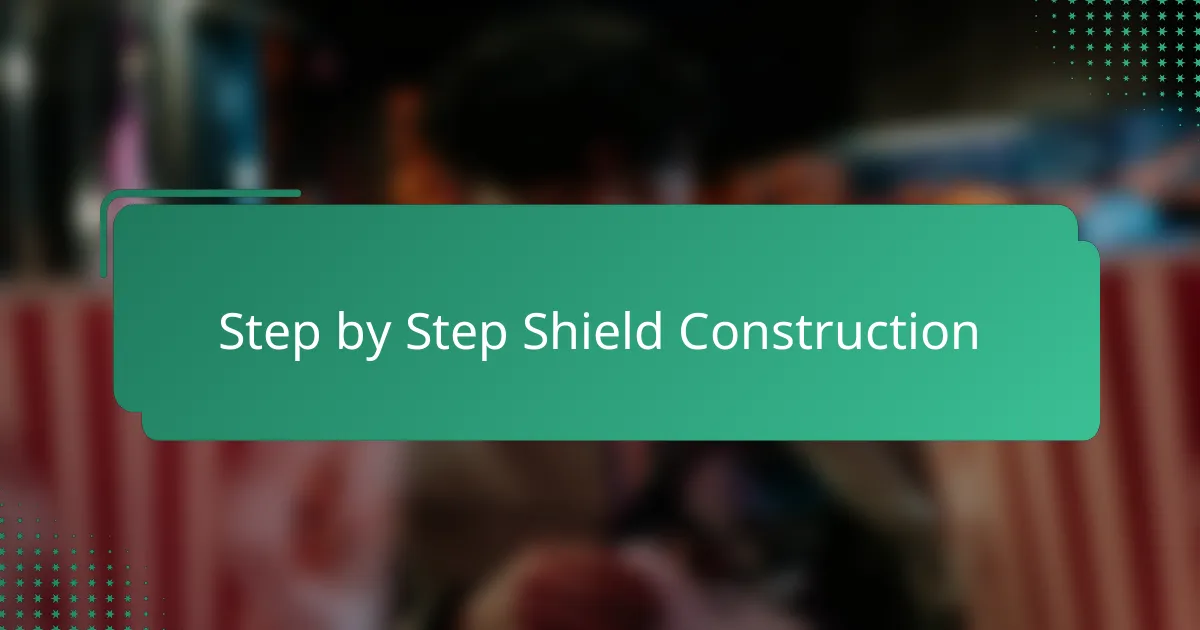Key takeaways
- Science fiction props combine creativity and realism, enhancing storytelling and sparking curiosity.
- Choosing the right materials, such as lightweight metals and translucent plastics, is crucial for creating believable and functional designs.
- Precision in using tools and measuring accurately can prevent costly mistakes during assembly.
- Flexibility and patience in the assembly process allow for adjustments that lead to better results and minimized frustration.

Understanding Science Fiction Props
Science fiction props are more than just objects; they are gateways to imaginative worlds. When I first started working with these props, I realized how much storytelling they carry—the design, materials, and wear all suggest a history and culture beyond our own.
Have you ever wondered why some props feel so authentic they almost seem alive? That’s because good science fiction props blend creativity with a hint of realism, making the impossible believable. I remember building my first prop and being surprised at how much attention to detail transformed it from a simple model to something that sparked curiosity and emotion.
Understanding these props means diving into both the art and science behind them. It’s about appreciating craftsmanship while imagining the futuristic technologies they represent. For me, this balance makes assembling and studying these props a rewarding experience that goes beyond mere hobby—it becomes a way to connect with visionary storytelling.

Materials Used in Sci-Fi Shields
When I first began assembling my reinforced shield, choosing the right materials felt like decoding a sci-fi puzzle. Lightweight metals like aluminum stood out to me because they balance durability with ease of handling—exactly what a futuristic shield should embody. I remember testing a few options and feeling that satisfying weight that promised both protection and agility.
Have you ever thought about how some sci-fi shields seem to shimmer or glow? That’s often achieved by layering translucent plastics or resin, which I found added a captivating depth without compromising strength. Incorporating these materials gave my shield that otherworldly vibe, making it feel like something straight out of a space opera.
Beyond the aesthetics, synthetic fabrics and foam inserts played a surprising role in my build. These materials offer shock absorption and comfort, which I initially underestimated but quickly grew to appreciate. It’s fascinating how combining hard and soft components can create a shield that’s not only visually impressive but also realistic in its suggested functionality.

Tools Required for Shield Assembly
When I first gathered tools for my shield assembly, I realized that precision was key. A reliable set of screwdrivers and a cordless drill became my best friends—they allowed me to secure parts tightly without fear of slipping or damaging delicate materials. Have you ever noticed how the right tool can make a tough task feel surprisingly manageable? That was exactly my experience here.
Cutting and shaping the components required some patience, so I reached for a sharp craft knife and a fine-toothed saw. There’s something almost meditative in carefully trimming the edges to fit perfectly, and having the right blade made all the difference between frustration and flow. I remember the satisfaction of that first clean cut—it was like bringing the shield’s form to life.
Of course, measuring accurately was essential to avoid costly mistakes. My trusted metal ruler and a digital caliper ensured every part aligned flawlessly. Looking back, I can say that investing in precise measuring tools saved me time and headaches, a lesson I took to heart as the shield gradually came together. Do you think the little details matter? In my experience, they absolutely do.

Step by Step Shield Construction
The first step in assembling my reinforced shield was organizing all the materials and tools on my workspace. I found that having everything laid out clearly helped me visualize the construction process and prevented those frustrating moments where you realize you’re missing a tiny screw or a crucial piece. Have you ever felt that moment of panic when you think you lost something vital? Being prepared ahead of time saved me from that more than once.
Next came the careful layering of materials—starting with the base aluminum plate, which I bolted firmly to give the shield its core strength. I remember pausing after this step, feeling the solid weight in my hands and thinking, “This is really becoming something.” It was a tangible sign that all the planning was paying off.
Attaching the outer resin layers and synthetic fabric involved a mix of precision and patience. Securing these with adhesive and tiny fasteners taught me how important subtle adjustments are; even a slight misalignment could throw off the whole balance. Does that kind of meticulous work ever feel tedious, or do you find it oddly satisfying? For me, it became a calming rhythm that made the shield truly come alive.

Reinforcement Techniques Explained
Reinforcement is where the shield truly earns its strength and character. In my experience, layering different materials strategically was like composing a symphony—each layer added not just durability but a distinct texture and purpose. It made me appreciate how science fiction props aren’t just about looking cool; they’re about believable function too.
One technique I relied on was integrating a lightweight metal core to bear impacts, then surrounding it with resin and fabric layers for flexibility and shock absorption. Have you ever noticed how that combo feels both solid and surprisingly agile? That balance was exactly what I aimed for and it changed how I handled the shield during assembly.
I also experimented with reinforcing edges by folding or doubling materials, which at first seemed tedious but quickly proved invaluable. Those reinforced edges helped maintain the shield’s shape and protected it from wear—details that you only appreciate after seeing how fast some parts can degrade without proper support. It made me realize just how vital reinforcement techniques are in bringing sci-fi props from fragile models to sturdy treasures.

Troubleshooting Common Issues
One issue I ran into early on was the outer resin layers cracking during assembly. I initially thought the resin was just fragile, but it turned out that uneven adhesive application caused stress points. Have you ever tried to glue something only to watch it warp or crack? Applying thin, even coats and letting each layer dry fully made a huge difference for me.
Another common snag was misaligned fasteners throwing off the entire balance of the shield. It felt frustrating—like the whole build was slipping out of sync. To fix this, I started marking exact drill points with a fine-tip pen before drilling. That small step saved me from many headaches and kept the shield sturdy and true.
Sometimes, the foam inserts shifted out of place after a day of handling, which surprised me at first. I realized that stronger adhesives and securing with hidden stitching helped keep everything snug. Have you ever discovered a quick fix that changed your workflow? In my experience, those little adjustments build confidence and make troubleshooting less stressful.

Personal Tips for Assembly Success
One tip I can’t stress enough is to take your time with each step—rushing often led me to overlook tiny misalignments that snowballed into bigger problems later on. Have you ever tried to fix something only to realize that a small slip early on caused the biggest headache? Waiting patiently and double-checking my work saved me a lot of frustration and made the whole assembly smoother.
I also found that keeping my workspace tidy wasn’t just about aesthetics; it actually kept my focus sharp and reduced the chance of losing vital pieces. When I was assembling my shield, a cluttered bench felt like a chaotic maze where I spent too much time searching for tools or fasteners. Clearing the space gave me mental clarity and helped me maintain a steady rhythm as I built.
Lastly, embracing flexibility in your approach can make a huge difference. For example, when a planned assembly step didn’t work perfectly, I paused and experimented with alternative methods rather than sticking rigidly to the instructions. Have you ever felt stuck and then found a simple tweak that transformed your progress? That willingness to adapt kept me motivated and often led to improvements I hadn’t initially considered.


